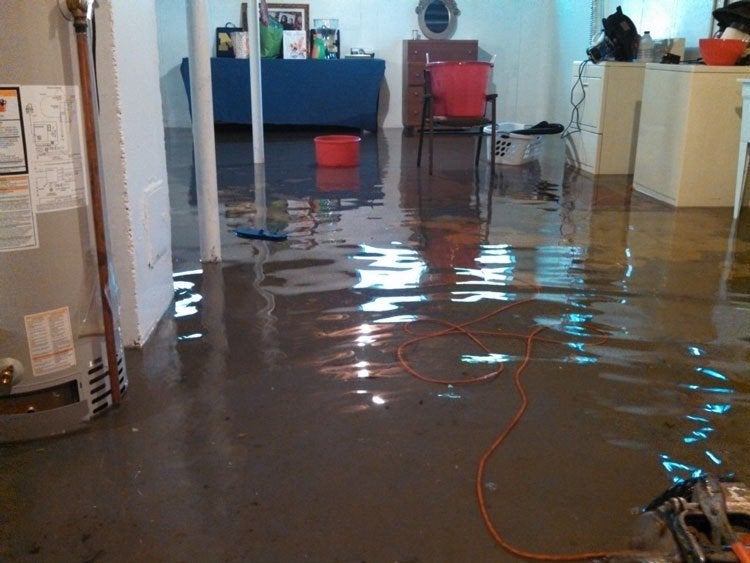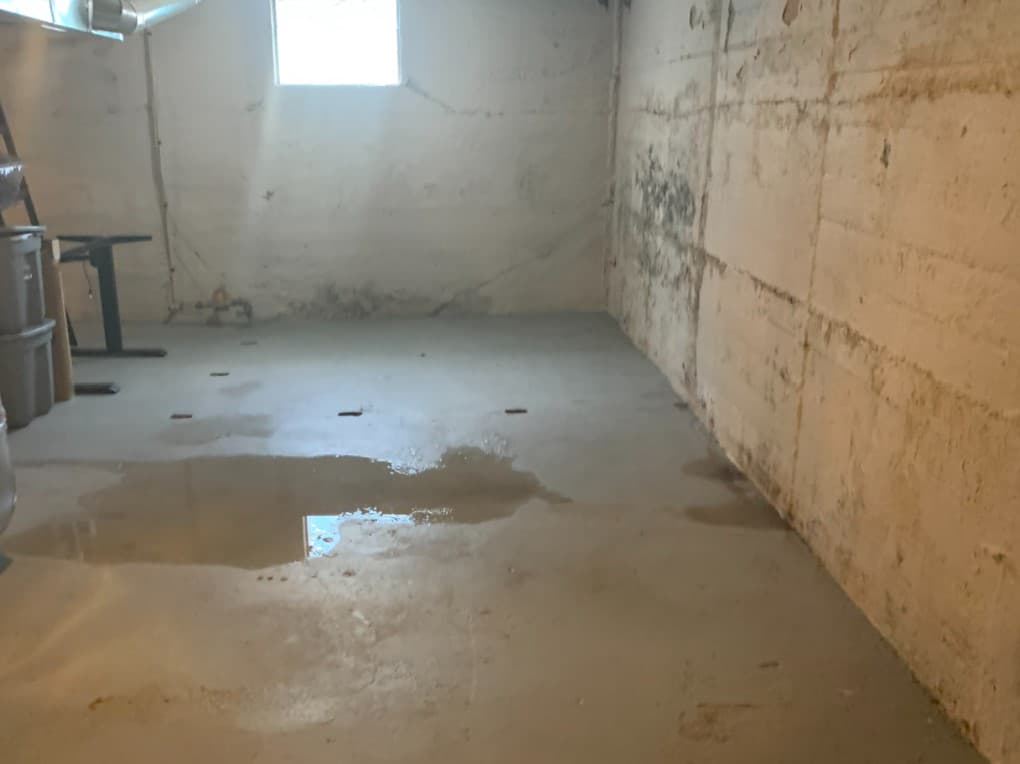The damp smell, the sight of water seeping through the concrete, the dread that sinks in with every drip – a flooded basement is a homeowner’s nightmare. But while many associate basements with leaks from pipes or overflowing washing machines, the truth is that water can rise up from below the floor. This isn’t magic, it’s a combination of factors that can make even the most sound basement susceptible to flooding.

Image: cinvex.us
Imagine this: you’re excitedly unpacking boxes in your newly renovated basement, only to discover a damp patch growing on the concrete floor. You start investigating and discover a chilling truth – the water isn’t coming from above, it’s rising from beneath. This is a common scenario for homeowners with basements, and while it can be terrifying, understanding the causes and solutions can help you prevent, mitigate, and even eliminate the issue altogether.
Understanding the Causes of Basement Flooding
While a flooded basement might seem like a mystery, the causes are often rooted in common issues. Primarily, the culprit is often the groundwater surrounding your house. Imagine your basement as a giant bathtub, and the ground around it as the surrounding water. If the water level in the “tub” rises, it can exert pressure on your basement floor, forcing its way in. This phenomenon is known as hydrostatic pressure.
Hydrostatic pressure is particularly prevalent in areas with high water tables, meaning the ground is saturated with water. Heavy rainfall, snowmelt, or a combination of both can contribute to this problem. Additionally, poor drainage around the foundation can also exacerbate the issue. If water pools around your home’s exterior, it can seep into the soil, increasing the pressure on your basement walls and floors.
Beyond Groundwater: Cracks and Other Contributing Factors
While groundwater is the primary cause, several other factors can contribute to a flooded basement. Cracks in your basement floor or walls can act as pathways for water to enter, especially if coupled with hydrostatic pressure. These cracks can be caused by a myriad of reasons, including:
Common Causes of Basement Cracks:
- Soil Movement: As the ground expands and contracts due to moisture changes, it exerts pressure on your foundation, potentially causing cracks.
- Foundation Settlement: Over time, the weight of your house can cause the foundation to settle, leading to cracks.
- Poor Construction: Improperly poured concrete or inadequate foundation design can also contribute to cracks.
- Tree Roots: Large tree roots growing near your foundation can exert pressure on the walls and floors, creating cracks.
Adding to the problem, leaking pipes or faulty plumbing can also contribute to basement flooding. While this is a more direct route for water into your basement, it often isn’t easily detectable until the damage is already done.

Image: dragon-upd.com
Identifying a Rising Water Problem
Detecting a rising water problem early on can make a huge difference in mitigating potential damage. Look for the following signs:
- Dampness and Musty Odors: The most common sign of rising water is a damp, musty smell in your basement.
- Visible Water Stains or Discoloration: Look for water stains on the walls, ceiling, or floor, indicating water seepage.
- Efflorescence: White powdery deposits on your basement floor or walls, often accompanied by a dampness, could be a sign of rising water.
- Buckling or Cracking in Floor Tiles: If you have tiles installed in your basement, they might buckle or crack due to water pressure.
- Standing Water: The most obvious sign is, of course, standing water in your basement, especially if it’s not caused by a recent leak.
Preventing Basement Flooding
The best way to deal with a flooded basement is to prevent it in the first place. Here are some tips for prevention:
Essential Steps for Prevention:
- Improve Drainage: Make sure your gutters are clean and functioning properly, and install downspouts that carry water far away from your foundation.
- Grade Your Yard: Ensure your yard slopes away from your house to divert rainwater away from the foundation.
- Install a Sump Pump: A sump pump is a vital tool for collecting and removing groundwater from your basement. It’s a worthwhile investment, especially in areas prone to flooding.
- Repair Cracks and Leaks: Address any cracks in your basement foundation or walls promptly. Repair leaking pipes and faulty plumbing to prevent moisture buildup.
- Invest in a Waterproofing System: Depending on your situation, you may want to consider comprehensive waterproofing solutions, such as:
- Interior waterproofing: Applying a waterproof membrane to the walls and floors.
- Exterior waterproofing: Installing a drainage system around the exterior foundation walls.
Remember, preventive measures are key to avoiding the frustration and expense of dealing with a flooded basement. By implementing these preventative steps, you lower the risk of facing a damp, soggy mess in your basement.
Addressing Basement Flooding
If you find your basement has already flooded, these are some things you can do:
Dealing with a Flooded Basement:
- Contact a Professional: It’s best to seek assistance from a qualified waterproofing contractor. They can assess the damage, identify the source of flooding, and recommend appropriate solutions.
- Remove Standing Water: If the water level is low, use a wet/dry vacuum or pump to remove the water. However, never attempt to remove large amounts of water yourself if you’re not equipped to do so. Call a professional in this case.
- Dry Out the Basement: Once the water is removed, use air movers or dehumidifiers to dry out the basement thoroughly. Moisture left behind can lead to mold growth, which can be a serious health hazard.
- Clean and Disinfect: Once the basement is dry, clean and disinfect the affected area using a bleach solution. This will help eliminate bacteria and mold spores.
- Inspect and Repair Damage: After the cleanup, carefully inspect the floors, walls, and foundation for any damage. Repair any cracks, leaks, or structural issues as soon as possible.
FAQs About Basement Flooding
Q: Can I fix a rising water problem on my own?
A: It depends on the severity and cause of the problem. Minor leaks can be addressed independently with proper sealing and patching. However, for larger issues, such as significant hydrostatic pressure or structural damage, it’s always best to consult a professional for a comprehensive assessment and repair.
Q: Is it always necessary to install a sump pump?
A: It highly depends on your location and the surrounding groundwater conditions. While it’s a great preventative measure, it might not be necessary if your basement is in an elevated area with well-maintained drainage and no signs of flooding.
Q: How much does basement waterproofing cost?
A: The cost can vary depending on the severity of the problem and the waterproofing system you choose. It’s best to get a professional estimate from a local waterproofing contractor to determine the precise cost.
Q: Does homeowners insurance cover basement flooding?
A: It depends on your insurance policy. Most standard homeowner’s insurance policies don’t cover flooding related to groundwater, but specialized flood insurance is available. It’s crucial to understand your coverage before a flood occurs.
Can Water Come Up From Basement Floor
Conclusion
A flooded basement can be a serious inconvenience and a costly repair. By understanding the causes of basement flooding, practicing preventive measures, and knowing how to address a flooded basement, you can protect your home and your investment. Remember, staying proactive is essential for preventing this common but frustrating issue.
Are you concerned about the possibility of water rising from your basement floor?



/GettyImages-173599369-58ad68f83df78c345b829dfc.jpg?w=740&resize=740,414&ssl=1)


